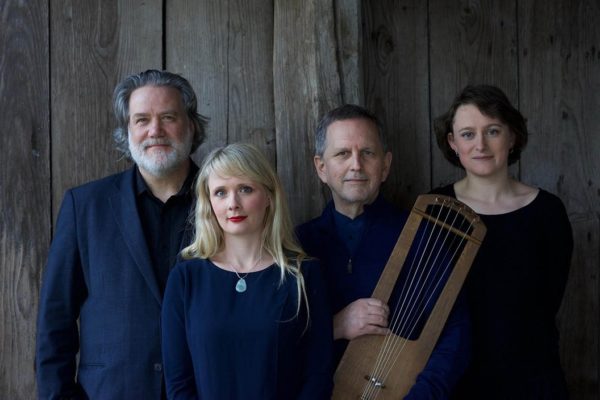Classical Music Review: At BEMF, Benjamin Bagby and Sequentia Seduce with Charms and Riddles
By Susan Miron
Thanks to BEMF for once again presenting Benjamin Bagby, who seems incapable of serving up anything but a wonderfully memorable experience.

Benjamin Bagby and Sequentia. Photo: courtesy of BEMF.
Many among the large Boston Early Music Festival audience who packed Jordan Hall on Wednesday evening undoubtedly knew of the singer/actor/harpist/scholar Benjamin Bagby from his famed recording of Beowulf or one of his extraordinarily engaging performances of the epic. Bagby sees himself as “a reconstructed singer of tales,” and his renditions of medieval works are invariably riveting. He is a singular phenomenon, a brilliant performer who finds daring and imagination by reaching back into the past. His flexible baritone voice, which ranges somewhere between declamation and real “singing,” can do whatever the drama calls for: it growls, declaims, teases, and whispers. He and his Sequentia collaborators have mastered both the memorization and treacherous pronunciation of Old English, drawing listeners (with the help of subtitles) into a medieval universe, where Anglo-Saxon bards performed sagas in mead halls lit by flickering fires. His three gifted collaborators for this show were Hanna Marti, voice & harps; Stef Conner, voice; and Norbert Rodenkirchen, wooden & bone flutes.
With “The Lost Songs Project: Charms, Riddles, and Elegies of the Medieval Northlands (8th–11th centuries),” Sequentia director Bagby marked the 30th anniversary of his BEMF début with an exploration of ancient music and poetry from across Germany, England, and Iceland. Bagby and his colleagues conjure up otherworldly sounds from an ancient era, focusing on songs about magic, healing, and exile. The program includes pagan laments and mystical celebrations, as well as allusions to legendary figures, such as England’s Beowulf and Iceland’s Edda. Bagby may be a scholar, but on stage he is all storyteller and reenactor. Performing this program, Bagby re-creates the role of the Anglo-Saxon scop (a reciter of poetry). He seemed to be electrified, almost under a spell much of the time. He declaimed and sang in a language first used between the 5th and 11th century — and the words have not lost their power to put listeners under a spell. You never doubt Bagby’s authenticity: consider his eyes, posture, pronunciation of the thorniest linguistic entanglements (and his gorgeous rolled r’s!), his hands, and the contorted ways he modulates his voice. He accompanies himself on a six-string harp (a reconstruction of Germanic harps based on 12th-century instruments from near Stuttgart) and on an early Medieval triangular harp (about 15 strings), which he puts to haunting use (the instrument was played mostly by Hanna Marti) with an exotic sound all its own (its strings were gut).
The first graduate of Oberlin Conservatory to earn a degree in Early Music, Bagby and his late wife Barbara Thornton, formed Sequentia (pronounced see-quen-she-a) in 1977. He began reconstructing his version of Beowulf in the mid-’80s and then moved onto other European repertoires of music (Anglo-Saxon, Icelandic, Old High German, to name a few) that have “vanished,” which means the surviving manuscripts do not provide enough information for reliable transcriptions. With the aid of musicologists and philologists, Bagby has assiduously and creatively reconstructed aged worlds, musical and literary. He has written over 70 programs for Sequentia: “Charms, Riddles, and Elegies” is full of spells — to bless a house, to manage a swarm of bees, to cure a fever, to stop bleeding, to protect against poisons, to cure worms, and so on. And there are clever riddles here as well, whose solutions, which appear in the subtitles, are genuinely funny. It is nice to know that some jokes don’t date.
Harp Nerd Alert
Bagby’s main six-stringed harp, built for him by Rainer Thurau (based on an instrument dug up in a 7th-century grave in Germany) resembles what know as a lyre. A harp builder reconstructed this piece, based on fragments found in Germany from the 7th century. Hollow inside, the instrument has 6 gut strings strung over a movable bridge (many of these harps were found north of the Alps). Not designed to play melody or chords, it works in only one mode. You need to re-tune it to move into other modes that will help support the singer. Associated with epic poetry, the instrument deftly fits the genre modally and rhythmically. It’s held on the left shoulder, and played primarily with right hand.
Bagby accompanied himself with modal turns and riffs varying between 3 and 7 notes. The triangular harp has 2 octaves. Sometimes b and e can be moved to flats. The smaller harp can be plucked and strummed.
“The tuning of the harp is the most complicated part,” Bagby has admitted. “There are indications of what the historical tunings were, but there were probably hundreds and every player had his own. It’s like the five-string banjo in Appalachian music. There’s no one tuning, and to the outsider it all seems like banjo music. But to those who really know modal mountain music, there are many different flavors.”
Many of Sequentia’s projects have eventually found their way onto recordings. This program might work on disc as well, though the album notes will be crucial because many of its delights are served up by the riddles. Those of us who were at Jordan Hall didn’t have any problem getting the punch lines. Thanks to BEMF for once again presenting Bagby, who seems incapable of serving up anything but a wonderfully memorable experience.
Susan Miron, a harpist, has been a book reviewer for over 30 years for a large variety of literary publications and newspapers. Her fields of expertise were East and Central European, Irish, and Israeli literature. Susan covers classical music for The Arts Fuse and The Boston Musical Intelligencer.
